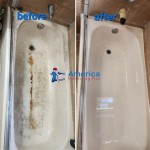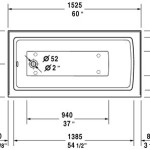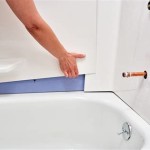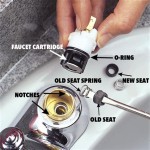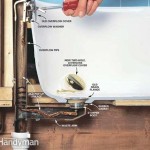How To Clean Rust From Bathtub Drain
Rust in a bathtub drain is a common problem, especially in areas with hard water or older plumbing systems. This reddish-brown discoloration not only detracts from the appearance of the bathtub but can also, over time, lead to clogs and restricted water flow. Understanding the causes of rust and implementing effective cleaning methods are crucial for maintaining a functional and aesthetically pleasing bathroom environment. This article provides a comprehensive guide to cleaning rust from bathtub drains, outlining various approaches and preventative measures.
The formation of rust is primarily due to the oxidation of iron. When iron or steel (an alloy of iron and carbon) comes into prolonged contact with water and oxygen, a chemical reaction occurs, producing iron oxide, commonly known as rust. In bathtub drains, this process is often accelerated by the presence of minerals in hard water, which can etch away protective coatings or introduce corrosive substances. Furthermore, the constant exposure to moisture and temperature fluctuations within the drain environment fosters rust development. Identifying the underlying causes in a specific situation can help prevent future recurrence after the initial cleaning.
Before initiating any cleaning process, it is vital to prioritize safety. Wear appropriate protective gear, including rubber gloves, to protect the skin from harsh cleaning agents. Ensure adequate ventilation in the bathroom by opening windows or turning on the exhaust fan, especially when using chemical-based cleaners. Gather all necessary materials and tools before starting the cleaning process to ensure a smooth and efficient workflow. Having everything readily available minimizes disruptions and reduces the risk of accidents.
Assessing the Severity of the Rust
The first step in cleaning rust from a bathtub drain is to assess the extent of the rust buildup. This assessment will determine the appropriate cleaning method and the necessary tools. Minor surface rust may be addressed with simple household remedies, while more severe rust accumulation might require more aggressive cleaning agents or even professional intervention.
Visually inspect the drain opening and any exposed pipes. Look for areas where the rust is most concentrated. Try to determine if the rust is primarily on the surface or if it has penetrated deeper into the metal. A flashlight can be helpful for illuminating hard-to-see areas within the drain. If the rust is accompanied by a foul odor or significantly restricted water flow, it could indicate a more serious problem, such as a blockage in the drainpipe. In such cases, addressing the underlying blockage is crucial before focusing on rust removal.
To better visualize the rust inside the drainpipe, consider using a small inspection camera, if available. These cameras can be inserted into the drain to provide a clearer picture of the condition of the pipe and the extent of the rust buildup. This information can be valuable in selecting the most effective cleaning method and avoiding unnecessary damage to the drainpipe.
Natural and Homemade Cleaning Solutions
For less severe rust stains, several natural and homemade cleaning solutions can be effective. These options are generally safer and more environmentally friendly than harsh chemical cleaners. They also offer a cost-effective alternative for tackling rust in bathtub drains.
Baking Soda and Vinegar: This classic combination is a powerful cleaning agent for various household tasks, including rust removal. Pour about one cup of baking soda down the drain, followed by one cup of white vinegar. The mixture will fizz and bubble as the baking soda reacts with the vinegar. Allow the mixture to sit in the drain for at least 30 minutes, or preferably overnight, to allow the baking soda and vinegar to loosen the rust. After soaking, flush the drain with hot water. Repeat the process if necessary. The abrasive nature of baking soda helps to dislodge rust particles, while the acidity of vinegar helps to dissolve them.
Lemon Juice and Salt: Lemon juice, with its high citric acid content, is another effective natural rust remover. Sprinkle a generous amount of salt around the drain opening and any visible rust. Pour lemon juice over the salt, ensuring that the rust is thoroughly saturated. Let the mixture sit for several hours or overnight. The salt acts as a gentle abrasive, while the lemon juice dissolves the rust. After soaking, scrub the area with a brush or sponge and flush with hot water.
Potato and Dish Soap: A surprising yet effective method involves using a potato and dish soap. Cut a potato in half and coat the cut side with dish soap. Rub the soapy side of the potato vigorously over the rusted areas of the drain. The oxalic acid in the potato helps to dissolve the rust. After scrubbing, rinse thoroughly with water. Repeat the process as needed.
Cream of Tartar and Hydrogen Peroxide: Cream of tartar, a mild abrasive, combined with hydrogen peroxide, a gentle oxidizing agent, can create a paste suitable for removing rust. Mix cream of tartar with enough hydrogen peroxide to form a thick paste. Apply the paste to the rusted areas and let it sit for several hours. Scrub the area with a brush or sponge and rinse thoroughly with water.
Commercial Rust Removal Products
For more stubborn or extensive rust deposits, commercial rust removal products may be necessary. These products typically contain stronger chemicals designed to dissolve rust quickly and effectively. However, it is essential to use these products with caution, following the manufacturer's instructions carefully and wearing appropriate protective gear.
When selecting a commercial rust remover, consider the type of metal in the drain and pipes. Some rust removers are specifically formulated for certain metals and may damage others. Read the product label carefully to ensure compatibility. Choose a product that is designed for use in drains and plumbing systems to avoid damaging the pipes.
Follow the manufacturer's instructions for application and contact time. Many rust removers require a specific soaking period to be effective. Avoid prolonged exposure, as this could damage the drain or pipes. Always rinse the drain thoroughly with water after using a rust remover to remove any residual chemicals.
Some popular commercial rust removal products include CLR (Calcium, Lime, Rust) cleaner, various industrial-strength rust removers, and specialized drain cleaners formulated to dissolve rust. Always test any product in an inconspicuous area first to ensure it does not damage the surface.
If using a chemical rust remover, ensure proper ventilation and wear appropriate protective gear, including gloves and eye protection. Avoid mixing different chemical cleaners, as this can create dangerous fumes. Store chemical cleaners out of reach of children and pets.
Preventative Measures
Preventing rust from forming in bathtub drains is crucial for maintaining a clean and functional bathroom. Implementing preventative measures can save time and effort in the long run and extend the life of the plumbing system.
Regular Cleaning: Regularly cleaning the bathtub drain with a mild cleaning solution can help prevent rust buildup. Use a mixture of baking soda and vinegar or a commercial drain cleaner every few weeks to keep the drain clear and prevent rust from accumulating. Flushing the drain with hot water after each use can also help remove any residual soap scum and minerals that can contribute to rust formation.
Water Softener: Hard water is a major contributor to rust formation. Installing a water softener can significantly reduce the mineral content of the water, preventing rust from forming in drains and pipes. Water softeners work by removing calcium and magnesium ions from the water, which are the primary culprits behind hard water. A whole-house water softener can benefit all plumbing fixtures in the home, not just the bathtub drain.
Protective Coatings: Applying a protective coating to the drain and surrounding metal parts can help prevent rust from forming. Several products are available that create a barrier between the metal and water, preventing oxidation. Consider using a rust-inhibiting primer or paint on exposed metal surfaces to provide an extra layer of protection.
Regular Inspections: Periodically inspect the bathtub drain and surrounding areas for signs of rust. Early detection can prevent rust from becoming a major problem. Address any rust spots as soon as they appear to prevent them from spreading. Look for leaks or drips around the drain, as these can contribute to rust formation.
Proper Ventilation: Ensure proper ventilation in the bathroom to reduce humidity levels. High humidity can accelerate rust formation. Use the exhaust fan during and after showers and baths to remove excess moisture from the air. Opening a window can also help improve ventilation.
Replacing Corroded Parts: If the rust is severe or recurring, consider replacing the corroded parts of the drain with new, rust-resistant materials. Stainless steel or plastic drain components are less susceptible to rust and can provide a long-term solution. Consult with a plumber to determine the best replacement options for the specific bathtub drain.
By understanding the causes of rust, implementing effective cleaning methods, and adopting preventative measures, homeowners can successfully clean rust from bathtub drains and maintain a clean, functional, and aesthetically pleasing bathroom.

3 Easy Ways To Remove Rust From A Bathtub Wikihow

How To Remove Rust Stains From Sink Tub Mr Handyman

Fix And Prevent Corrosion On A Bath Tub Drain Hometalk

How To Remove Rust Stains From A Porcelain Tub Or Sink Cabana State Of Mind

3 Easy Ways To Remove Rust From A Bathtub Wikihow

3 Easy Ways To Remove Rust From A Bathtub Wikihow

Easily Remove Bathtub Rust With This Common Kitchen Pantry Ingredient

How To Fix The Enamel On A Bathtub Stop Rust Formation

How To Remove Rust Stains From Toilets Tubs And Sinks

Common Housekeeping Conundrums Rust In Bathtubs And Sinks

